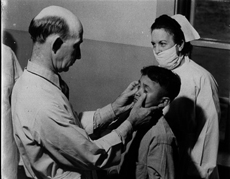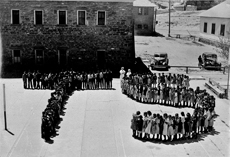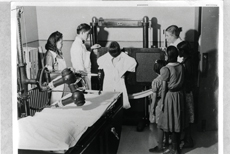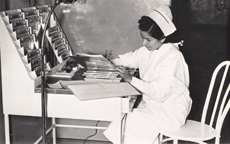The Meriam Commission and Health Care Reform (1926-1945)
A movement began in the 1920's to thoroughly inspect the administration of Native American programs directed by the Office of Indian Affairs. It resulted in the formation of the Meriam Commission, a survey team comprising specialists from various fields, including medicine. The commission was headed by Lewis Meriam, an employee of the Interior Department. The medical specialist inspected reservation, school, and hospital settings and the commission issued a report to Interior Secretary Hubert Work in 1928. It documents substandard health conditions due to government inefficiency and lack of adequate funding.
One of the institutions visited and evaluated by the commission was the Canton Insane Asylum for Indians in Canton, Ohio. The Meriam Report, as it is popularly called, is quoted here, from pages dealing with the Canton asylum.
The Meriam Commission's findings spurred a movement during President Franklin D. Roosevelt's administration to improve health conditions for Native Americans. One reform made during this time was the active solicitation of Native American medicine men to participate in federal health provision to their people. This had formerly been discouraged by government assimilationist policy.
Exhibit Case 5
"As stated previously adults and children are housed in the same quarters; only the more violent cases are segregated in single rooms. Cases of tuberculosis were reported in the hospital building, but no precautions were being taken to protect the other patients from them, nor were their dishes sterilized.
It was impossible to study the diet served patients, as no file of menus was available. On the day of the visit, it consisted of a stew of meat and carrots, with more fat and bones than anything else, thin apple sauce, bread, and coffee. Proper facilities, such as tables in ward dining rooms, and personnel to supervise the patients at their meals, were lacking. Several patients were eating from the floor.
Since the personnel in attendance is untrained and limited in number, the patients receive but a minimum of care. The first trained nurse for this institution was engaged in April, 1927. She received her training at St. Elizabeth's Hospital in Washington, D.C., and appeared to be very capable but bewildered at the responsibilities thrust upon her. This institution had twenty-four employees, including farmers, day laborers, and those engaged in caring for patients.
As in all institutions of this character, much of the manual labor about the place is done by patients who are able to work. Clinical records of cases in this institution are inadequate. It was impossible to obtain a complete picture of the case from the avialable notes. A monthly statement of the physical condition of each patient is sent to the superintendents of the agencies from which they came.
One case in particular was studied; a young boy sent there from Arizona. The facts in the case as presented in clinical notes and correspondence would indicate that the reservation superintendent was determined to have this boy hospitalized, despite the fact that the superintendent of the hospital reported repeatedly that he was not a case for this institution, as he had been unable, after several months of observation to determine any sufficient cause for hospitalization. At the time of the survey visit, correspondence was still in progress between the two superintendents and the Indian Office. It seemed obvious, however, that the agency superintendent was determined to be rid of this boy. This conclusion was strengthened after comparing notes with a member of the survey staff who had studied the facts of the case on the reservation from which the boy came. He was subsequently sent home." -- Dr. Herbert R. Edwards
Source: The Problem of Indian Administration: Report made at the request of Honorable Hubert Work, Secretary of the Interior, and submitted to him, February 21, 1928, (Meriam Report), pp. 307-8.
"Female Census" of Canton Asylum for Insane Indians, taken by its superintendent, H. R. Hummer, M.D. Part of his letter to the Commissioner of Indian Affairs, July 1, 1926 [not shown in online exhibition].
"'How about the general health conditions of the Pottawatomies and scattered Chippewas living around here?' I question next.
"'They live in such abject squalor that it is no wonder their resistance is low. In winter they use green wood for heating; they never have enough blankets. There is no ventilation in their homes; the windows are nailed down for the winter and the dogs stay indoors with them. In the fall they put on two or three layers of clothing and never remove them until spring. They are undernourished. They live on bread, baked by themselves and of the poorest quality. They also exist on salt pork, tea, but no milk; out of 600 Indians there are not more than one or two cows among them. Only a few raise vegetables. They all live out of a can in the winter.
"'Sanitation? Hell, they have no sanitation. Three-fourths of them have no outhouses. They use the grass fields and the brush. Once in a while you will see a well. The majority use springs or dam up a stream.'"
"'Where is the hospital located for Indians of this territory?'" I ask next.
"'There isn't any,'" is his reply. "'On May 11, 1929, Congressman Schneider of Appleton introduced a bill, H. R. 2860, authorizing the expenditure of $125,000 for a fully equipped Indian hospital in Forest County. But the Indian Bureau recommended to the Indian Affairs Committee that the hospital not be built. Schneider believes that the Indian Bureau doesn't want to do anything for the Indian. Personally, I can see how and where they have been a failure. That bill is still pending with the House Indian Affairs Committee. It has never been passed. I can't understand it, for there certainly is a need for it. White people are taken to hospitals in ambulances and I don't see why the same shouldn't be done with Indians.'"
Source: Robert Gessner, Massacre: A Survey of Today's American Indian, 1931, pp. 202-3 from Part IV: Health.
Coming after and sometimes quoting the Meriam Report, this book describes conditions on U.S. reservations.

Dr. W. P. Whitted examines the eyes of a trachoma patient, Trachoma School, Fort Defiance, Arizona, 1941.
Courtesy National Archives and Records Administration

"T" stands for Trachoma, "S," for Sulfanilamide. Trachoma School, Fort Defiance, Arizona, 1941
Courtesy National Archives and Records Administration

Nurse Mary B. Russell (right) and Assistants Mae Howard and Roland Begay (left) take a chest x-ray of a patient. Trachoma School, Fort Defiance, Arizona, 1941
Courtesy National Archives and Records Administration
"For the little more than 2 years the school has been running, 150 children have had their eyes up and sent back to other schools, 109 of these have been positive cases and 41 suspicious cases. By suspicious cases are meant the ones that have very suspicious signs of trachoma on the lids but on whom I was never able to definitely diagnose a pannus with the hand slit-lamp.
At present the enrollment at the school is 208. This may appear as quite a number left with the 50 arrested cases, but new cases have been brought in from other schools on the reservation: 3 government and 2 Mission schools. All children in these schools are examined every 2 to 3 months and any new cases found or old cases found that have flared up are transferred to Fort Apache. Fourteen cases having flared up and having to be re-admitted since the school has been in operation may seem like a good number, but considering the homes the children go back to, I think we are lucky to have no more readmissions than this." --James C. Hancock, M.D., Special Physician, U.S. Indian Service.
Source: James C. Hancock, "Trachoma Treatment at Fort Apache 'Trachoma School'," Southwestern Medicine, Vol. 21, 1937, p. 81.
Hancock was a government physician in the Indian Service.

A Native American nurse works on hospital records.
from Nomenclature of Diseases and Conditions and Hospital Record Manual, Office of Indian Affairs Health Division, 1943.
"Indian Health--Past, Present, and Future," by J. G. Townsend. An article In Oliver La Farge's book, The Changing Indian, 1942 [copyrighted book, not shown in online exhibition].
Last Reviewed: March 5, 2024


